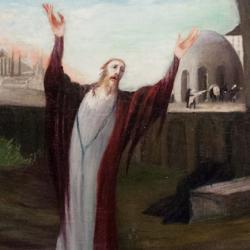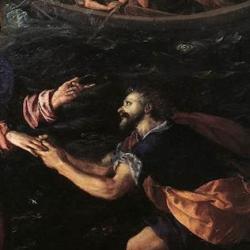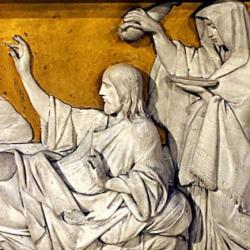Matthew 11:25-27 is mainly organized as a chiasm:
A. Father hides and reveals as is well-pleasing, vv 25-26
B. Father gives all to the Son, v 27a
C. No one knows Son, v 27b
D. except the Father, v 27c
D’. No one knows Father, v 27d
C’. except the Son, v 27e
A’. Son reveals as He wills, v 27f
A couple of points follow from this structure.
First, at the center of the chiasm, we have a Celtic knot. Considered as a chiasm, the order is Son/Father/Father/Son. But if we look instead at the verbs and prepositions, the arrangement is: know/except/know/except. The chiasm of Persons is intertwined with a parallel structure in the grammar. Second, this Celtic knot manifests textually the intertwining of mutual love and knowledge that the text is speaking about. Father and Son know one another with complete, mutual, and exclusive knowledge. They form a closed circle of knowledge, and the text portrays this by tying off all the edges in its endless self-enfolding. The text is an Escher drawing: Follow the path from the Father, and it recoils seamlessly back to the Son, and from the Son to the Father; the upward path to the Father blends into the downward path to the Son. Third, obviously, the point of the passage is that some – babes! – are knotted together into this knot with the Father and Son. The Father reveals (v. 25; Gr. apokalupto ), and the Son reveals (v 27); the Father unveils Himself and so does the Son, so that the exclusive, complete, mutual knowledge, the closed knot is opened.
Fourth, though the Father’s good pleasure is stated as the reason for the upside-down revelation of verses 25-26, by the time we get to the end of verse 27, the Son’s will has come into play as well. Whose good pleasure determines that the things of the kingdom are revealed to babes? The Father’s, which is the Son’s, because the Father and Son are knotted in mutual love and knowledge. The mutual knowing announced at the center of verse 27, in short, implies a knotting of wills as well.
And that, finally, might explain the absence of a B’ in the structure. Nothing appears to correspond structurally to the Father’s gift of all things to the Son. Perhaps the last clause of verse 27 is an A’/B’ together: The reason that the Son’s will determines the ones to whom the Father is unveiled is that the Father has given all things to the Son. The Son does nothing of Himself, but what He sees the Father doing, and in giving the Son all things the Father gives the Son to unveil Him, and Himself.











